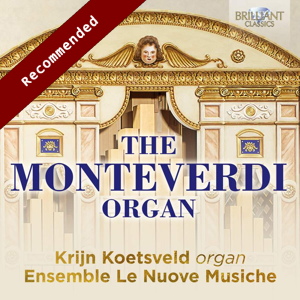
The Monteverdi Organ
Ensemble Le Nuove Musiche/Krijn Koetsveld (organ)
rec. 2020, St Martinuskerk, Hoogland, Netherlands
Texts and translations included
Brilliant Classics 96347 [72]
The music of Claudio Monteverdi and his Italian contemporaries is performed across the world and appears frequently on disc. The problem performers outside Italy are facing is that they don’t have access to the appropriate organs for the performance of the basso continuo. And even in Italy there may be hardly any instrument to find that is in accordance with Monteverdi’s own ideals. The booklet that accompanies the disc under review here, includes an interesting quotation from 1610 which reveals what kind of organ Monteverdi had in mind. “Every Friday music is performed in the hall of mirrors [in Mantua]. Signora Adriana comes to sing and transforms the hall into a kind of theatre. I will have the theorbo players from Casale play, accompanied by the organo di legno, which is incredibly suave”. And in the score of his opera L’Orfeo he required duoi organi di legno.
This refers to an organ with wooden, open pipes, which produces a soft and refined sound and has a delicate intonation, which – according to the Dutch organ builder Willem Hermans, who worked in Italy from 1648, is “very suitable for mixing with the human voice and with the instruments”. Cypres wood is considered the ideal kind of wood for an organo di legno.
The Dutch keyboard player and conductor Krijn Koetsveld became hooked by the music of Monteverdi, and with his ensemble Le Nuove Musiche he recorded the complete madrigals for Brilliant Classics. In the course of the project he was thinking about the organ that Monteverdi considered ideal and wondered whether it would be possible to build such an instrument. The problem is that no such organ from Monteverdi’s time has been preserved. The only option was to reconstruct such an instrument on the basis of descriptions. The Dutch firm Klop Organ Builders, which is known across the world for its building of organs and harpsichords after historical models, was commissioned to build what has become known as the ‘Monteverdi organ’. It has been used several times in concerts, for instance during the annual Festival Early Music Utrecht. The present disc is the first, where it can be heard both in solo works and in the basso continuo in a selection from Monteverdi’s Selva morale e spirituale.
For the pieces for organ solo one does not necessarily need this kind of organ. In Italy one can find quite a number of instruments, on which the music by Frescobaldi and other Italian composers can be perfectly realised. Koetsveld also included some pieces by Fresobaldi’s pupil Johann Jacob Froberger, which are written in the Italian style. However, these organ works are perfectly suited to show the characteristics of the organ, and it is nice to hear them in a different way. It is notable that the blowing action is done by hand; during the recording three people, including two of the singers, acted as calcants.
One of the main qualities of an organo di legno, as the quotations included in previous paragraphs indicate, is the fine blending of the organ with voices and instruments. That was my impression during the live performances, and it is confirmed here. In live performances and in recordings it is mostly a small positive that it used for the basso continuo. Often it is hardly audible. If a player wants to make it heard, it is sometimes too loud and can be obtrusive. That is no problem here. It is “suave” indeed, as Monteverdi called it. This instrument is really a wonderful addition to the instruments used for performances of the music by Monteverdi and his contemporaries, and I think that performers elsewhere, for instance in the UK, should consider purchasing such an instrument rather than making use of the Hauptwerk virtual organ system, as is the case in several recent recordings.
As far as the performances are concerned, I am very happy with this recording. Krijn Koetsveld delivers stylish performances of the organ pieces. The variety in organ stops is effectively explored. Falco van Loon perfectly matches the organ in Frescobaldi’s Recercar con obligo di cantare la quinta parte senza toccarla. The pieces from the Selva morale e spirituale receive excellent performances from Le Nuove Musiche. They have performed and recorded Monteverdi’s madrigals, which guarantees that their voices blend perfectly. Their experience also explains the declamatory approach to these pieces. I would like to single out Bas Ramselaar who delivers a brilliant performance of one of Monteverdi’s most demanding solo pieces, Ab aeterno ordinata sum, which requires a very wide tessitura.
Even if you have all or most of the pieces recorded here in your collection, you should not miss this disc. It is wonderful stuff, and from the perspective of performance practice I would label it groundbreaking.
Johan van Veen
Help us financially by purchasing from



Contents
Johann Jacob FROBERGER (1616-1667)
Toccata IX (FbWV 109)*
Claudio MONTEVERDI (1567-1643)
Salve Regina III (SV 285)
Johann Jacob FROBERGER
Toccata I (FbWV 101)*
Claudio MONTEVERDI
O ciechi il tanto affaticar (SV 252)
Tarquinio MERULA (1595-1665)
Capriccio La Loda*
Claudio MONTEVERDI
Ab aeterno ordinata sum (SV 262)
Girolamo FRESCOBALDI (1583-1643)
Toccata cromaticha per l’Elevazione (1635)*
Ricercar con obligo di cantare la quinta parte senza toccarla (1635)*
Canzon post il Comune (1635)*
Claudio MONTEVERDI
Salve Regina II (SV 284)
Tarquinio MERULA
Canzone II
Claudio MONTEVERDI
Spuntava il di (SV 255)
Girolamo FRESCOBALDI
Capriccio sopra la bassa fiamenga (1626)*
Claudio MONTEVERDI
Et iterum venturus est (SV 261)
Girolamo FRESCOBALDI
Toccata IX (1637)*
Claudio MONTEVERDI
Laudate pueri II (SV 271)
(*) organ solo


















